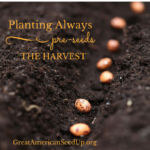Eleven Ways to Share Seeds
by Guest blogger: Kari Spencer
of Great American Seed Up
Listen to the Seed Up In a Box podcast HERE
 The Great American Seed Up is a project started in Phoenix with the ultimate goal to make a difference in the local food security for communities across the nation and around the world. The way to do this was to empower people through education on seed saving through in-person educational presentations and provide access to bulk seeds with a very unique seed bazaar. We are committed to providing adaptable, non-GMO, heirloom seeds to as many people as possible across the nation, for growing and saving even during this challenging time.
The Great American Seed Up is a project started in Phoenix with the ultimate goal to make a difference in the local food security for communities across the nation and around the world. The way to do this was to empower people through education on seed saving through in-person educational presentations and provide access to bulk seeds with a very unique seed bazaar. We are committed to providing adaptable, non-GMO, heirloom seeds to as many people as possible across the nation, for growing and saving even during this challenging time.Although we can’t get together in big groups in person this year, sharing seeds is still possible. We’ve reorganized to create our Seed Up In a Box. To get seeds into the hands of growers like you, we’ve packaged our bulk seed into bundles priced at almost 50% off our already amazingly low in-person prices and moved access to our seed education to an online Student Portal. In addition, the seed varieties in our program are adaptable and resilient – not zone-dependent – so you can share them nationwide. Each variety includes enough seed for TEN generous servings.
Whether you order seeds in bulk or you grow your own, if you have extra seeds to share, here are 11 ways to help everyone get growing while still social distancing.
1. Start a safe seed swap.
Post on your community’s social media outlets, such as Nextdoor, listservs or gardening Facebooks group that you have seeds to share. Set up a publicly accessible location so that people can take and leave seeds without having to meet face to face. Clearly label the seeds you trade and keep them in a waterproof container, such as a jar or plastic bag (if you will be leaving them outside).
2. Swap seeds by mail.
Mail swaps take a little more work than local swaps, but it is fun to connect with gardeners across the country. To keep work manageable, limit participants to about a dozen. Set a deadline for seeds to be shipped to the host. For a swap with a dozen people, everyone would send the host 12 seed packets in a cushioned envelope, along with cash to cover postage (typically no more than $5). The swap host then divides up the seed packets amongst the participants, packages them, and mails them back out. Alternatively, set a deadline to mail seeds and have each participant send a packet to every other participant on the list.
3. Donate seeds.
Share with local community gardens, schools, food banks, group homes and gardening groups. If you have skills to share, offer to teach a class to these groups in person or online.
4. Make seed paper cards.
Turn recycled paper into a greeting card that you can plant! Give it to someone special to plant in a pot or in the ground.
5. Hand out seeds this Halloween.
Give kids (or adults!) a few easy-to-grow seeds and simple growing instructions. Or if you’re feeling crafty, make Halloween seed paper party favors with pulverized paper blended with seeds (follow the link above for making seed paper cards). Shape them with a cookie cutter to resemble pumpkins, bats or other Halloween images. Recipients can plant their favor to grow wildflowers, herbs or vegetables.
6. Organize a seedling exchange.
Creating seed starts for an entire garden can be cumbersome. Make it easier by dividing the work amongst several gardening friends. Decide together what varieties you want to grow. Each person will start seeds for one or two varieties, growing enough seedlings for themselves and enough to share with the rest of the group. Arrange a day to exchange the seedlings. You may even want to help each other plant! Gardening together outdoors can be a safe social activity.
7. Share your knowledge with kids.
With so many kids schooling at home, parents may be looking for hands-on activities to supplement their learning. In the fall, send the participants packets of seeds and an invitation to learn how to grow them. Parents can hang the seeds on a bulletin board or create a garden notebook in which to save them until spring. During the winter, organize online gardening classes or small in-person activities to teach the kids how to grow their seeds. Classes can be simple, or as in-depth as you want. There are endless topics to get kids interested in gardening and many of them can be taught hands on. A few ideas for classes are as follows: soils, garden prep and planning, seed starting, caring for a garden, harvesting, seed saving, making seed balls and food preservation. Life Lab offers some great lessons plans and videos for garden-based education.
8. Plan an in-person seed swap
Hold it on National Seed Exchange Day (the last Saturday in January) if social distancing allows. The beauty of local seed swaps is that gardeners from the same area can share tricks and tips for what works best in that particular climate. As an added bonus, local swappers can also trade plant cuttings or rootings that might not do as well via mail. Be sure to have a back-up plan should it be required.
9. Host your own Seed Up!
Order a package of seeds at GreatAmericanSeedUp.org. We’ll provide you with the materials you need to start (seed, seed cards, and baggies), access to signage and info on how to set up seed stations for your event, and lots of educational materials to share with your community.
10. Make amazing gardening gift sets for 10 or more families and friends.
Start with one of our bundles and divvy the varieties up into suggested servings, add a Basic Seed Saving Book, maybe throw in a City Farming book too, and you have an amazing gift that can start a new gardener or urban farmer off with a bang. This is truly a gift that can keep on giving for a lifetime!
11. Host a watch party.
Your seed bundle includes access to our seed education student portal. Whether you gift the seeds to friends or split the cost with a group, you can view the educational videos together, providing an opportunity to learn together and socialize safely. Use Zoom or other online conferencing service to screencast the videos for participants to watch. You could also hold a chat discussion during the videos and/or verbal discussion following.
Things to remember:
Whichever method of seed swapping you choose, there are a couple of important guidelines to remember and share with your fellow swappers:
- Make sure you include enough seeds in each packet to produce a decent harvest. A dozen tomato or pepper seeds is more than enough, but for a crop like corn or beans it makes more sense to include at least 20.
- Packaging is important. Mini plastic zip-top bags or manila coin envelopes make great seed packets, or make your own like these or these. Label the seed packets with the variety, some basic growing information, and your contact information in case recipients have any questions.
Seed swapping is a great way to build relationships with fellow gardeners and build your personal seed library. No matter how small or how large, whether in person or socially distant, seed swaps are a fun perk of being a gardener.
UrbanFarm.org/shareseeds
About this author:
 Kari is a popular local gardening & homesteading speaker. As a Master Gardener and a Master Farmer, she enjoys sharing her passion for growing and raising food with others. In addition to teaching classes all over the city of Phoenix, she is the creator of Urban Farm U’s Growing Food the Basics & Backyard Livestock courses.
Kari is a popular local gardening & homesteading speaker. As a Master Gardener and a Master Farmer, she enjoys sharing her passion for growing and raising food with others. In addition to teaching classes all over the city of Phoenix, she is the creator of Urban Farm U’s Growing Food the Basics & Backyard Livestock courses.
She and her family operate The Micro Farm Project, a small farm in North Phoenix, where gardens and livestock animals provide her family with fun and food. Her new book City Farming: How-To Guide to Growing Crops & Raising Livestock in Urban Spaces, by 5MPublishing has just been released.
Website: GreatAmericanSeedUp.com
*Disclosure:
Some of the links in our podcast show notes and blog posts are affiliate links and if you go through them to make a purchase, we will earn a nominal commission at no cost to you. We offer links to items recommended by our podcast guests and guest writers as a service to our audience and these items are not selected because of the commission we receive from your purchases. We know the decision is yours, and whether you decide to buy something is completely up to you.






